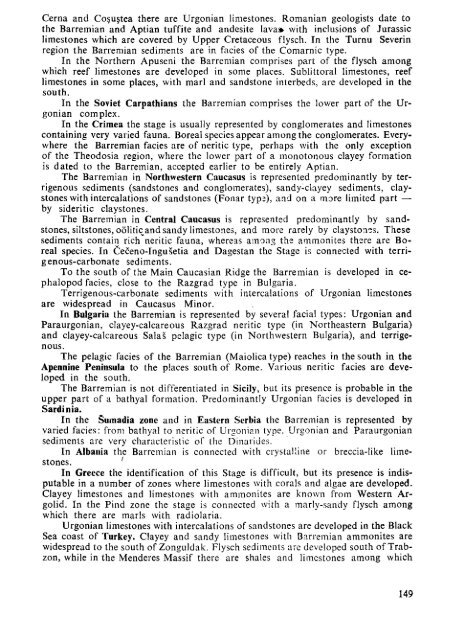THE MEDITERRANEAN LOWER CRETACEOUS
THE MEDITERRANEAN LOWER CRETACEOUS
THE MEDITERRANEAN LOWER CRETACEOUS
Create successful ePaper yourself
Turn your PDF publications into a flip-book with our unique Google optimized e-Paper software.
Cerna and Coçustea there are Urgonian limestones. Romanian geologists date to<br />
the Barremian and Aptian tuffite and andésite lava» with inclusions of Jurassic<br />
limestones which are covered by Upper Cretaceous flysch. In the Turnu Severin<br />
region the Barremian sediments are in facies of the Comarnic type.<br />
In the Northern Apuseni the Barremian comprises part of the flysch among<br />
which reef limestones are developed in some places. Sublittoral limestones, reef<br />
limestones in some places, with marl and sandstone interbeds, are developed in the<br />
south.<br />
In the Soviet Carpathians the Barremian comprises the lower part of the Urgonian<br />
complex.<br />
In the Crimea the stage is usually represented by conglomerates and limestones<br />
containing very varied fauna. Boreal species appear among the conglomerates. Everywhere<br />
the Barremian facies are of neritic type, perhaps with the only exception<br />
of the Theodosia region, where the lower part of a monotonous clayey formation<br />
is dated to the Barremian, accepted earlier to be entirely Aptian.<br />
The Barremian in Northwestern Caucasus is represented predominantly by terrigenous<br />
sediments (sandstones and conglomerates), sandy-clayey sediments, claystones<br />
with intercalations of sandstones (Fonar typ;), and on a more limited part —<br />
by sideritic claystones.<br />
The Barremian in Central Caucasus is represented predominantly by sandstones,<br />
siltstones, oolitic and sandy limestones, and more rarely by claystones. These<br />
sediments contain rich neritic fauna, whereas among the ammonites there are Boreal<br />
species. In Ceceno-Ingusetia and Dagestan the Stage is connected with terrigenous-carbonate<br />
sediments.<br />
To the south of the Main Caucasian Ridge the Barremian is developed in cephalopod<br />
facies, close to the Razgrad type in Bulgaria.<br />
Terrigenous-carbonate sediments with intercalations of Urgonian limestones<br />
are widespread in Caucasus Minor.<br />
In Bulgaria the Barremian is represented by several facial types: Urgonian and<br />
Paraurgonian, clayey-calcareous Razgrad neritic type (in Northeastern Bulgaria)<br />
and clayey-calcareous Salas pelagic type (in Northwestern Bulgaria), and terrigenous.<br />
The pelagic facies of the Barremian (Maiolica type) reaches in the south in the<br />
Apennine Peninsula to the places south of Rome. Various neritic facies are developed<br />
in the south.<br />
The Barremian is not differentiated in Sicily, but its presence is probable in the<br />
upper part of a bathyal formation. Predominantly Urgonian facies is developed in<br />
Sardinia.<br />
In the Sumadia zone and in Eastern Serbia the Barremian is represented by<br />
varied facies: from bathyal to neritic of Urgonian type. Urgonian and Paraurgonian<br />
sediments are very characteristic of the Dinariues.<br />
In Albania the Barremian is connected with crystalline or breccia-like limestones.<br />
'<br />
In Greece the identification of this Stage is difficult, but its presence is indisputable<br />
in a number of zones where limestones with corals and algae are developed.<br />
Clayey limestones and limestones with ammonites are known from Western Argolid.<br />
In the Pind zone the stage is connected with a marly-sandy flysch among<br />
which there are marls with radiolaria.<br />
Urgonian limestones with intercalations of sandstones are developed in the Black<br />
Sea coast of Turkey. Clayey and sandy limestones with Barremian ammonites are<br />
widespread to the south of Zonguldak. Flysch sediments are developed south of Trabzon,<br />
while in the Menderes Massif there are shales and limestones among which<br />
149

















